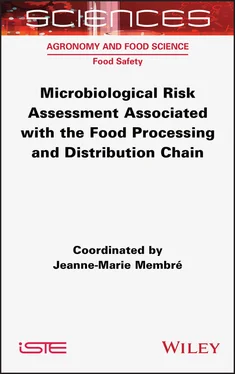Risk analysis Risk analysis Confronted by these dangers for more than 20 years, the development of food safety standards has been based on a formal process called “risk analysis”. Risk analysis includes risk assessment and risk management as well as risk communication ( Figure I.2 ). The Food and Agriculture Organization of the United Nations (FAO) and WHO define risk assessment as a decision-making tool: its aim is not necessarily to extend scientific knowledge, but to provide risk managers with a rational and objective picture of what is known, or assumed to be known, about public health risks and their causes at any given time. Figure I.2. The three components of risk analysis: risk assessment, risk management and risk communication. Adapted from the FAO and WHO (2006) No matter what the institutional context, the discipline of risk analysis offers a tool that all public authorities can use to improve food safety (FAO and WHO 2020). This book focuses on risk assessment and more specifically on microbiological risk assessment. Readers interested in chemical risk assessment can refer to a number of books and in particular to the recent book coordinated by Camel et al. (2018).
Microbiological risk assessment References
7 PART 1: Hazards and Food 1 Biological Hazard Identification 1.1. Introduction 1.2. Who conducts hazard identification? 1.3. Sources of useful information for hazard identification 1.4. An example of the use of data in hazard identification, exposure assessment and risk characterization 1.5. The hazard identification process 1.6. Scientific work on hazard identification 1.7. Conclusion and perspective 1.8. References 2 Detection and Enumeration of Foodborne Pathogens and Bacterial Toxins in Food 2.1. Why should we look for pathogens in food? 2.2. Conventional culture-based methods: how to detect and quantify pathogenic bacteria in food 2.3. Nucleic acid-based methods 2.4. Immunology-based assays 2.5. Other methods 2.6. References 3 Exposure Assessment of Microbial Pathogens 3.1. Introduction/state of the art 3.2. Construction of a food-pathway model 3.3. Conclusion 3.4. References
8 PART 2: Food and Risk 4 Pathogenic Mechanisms of Bacterial Foodborne Pathogens 4.1. Introduction 4.2. Foodborne pathogens and diseases 4.3. Pathogenic mechanisms of foodborne pathogens 4.4. Prospects for ongoing studies 4.5. References 5 Microbial Dose–Response Models 5.1. Introduction 5.2. Main dose–response models 5.3. Fitting data to a dose–response model 5.4. Discussion and conclusion 5.5. References 6 A Guide for Microbiological Risk Characterization 6.1. Introduction 6.2. Qualitative and semi-quantitative risk characterization 6.3. Quantitative measures of risk 6.4. From results of risk assessment to the application of measures in the food chain 6.5. Concepts of variability and uncertainty in the context of risk characterization 6.6. Risk characterization by taking into account variability and uncertainty 6.7. Software tools and good practices for risk characterization 6.8. References
9 Conclusion Scientific work on microbiological risk assessment Integration of microbiological risks into a more general risk assessment process Risk ranking of hazards References
10 Appendices Appendix 1. Hazard identification – Example of cooked ham Appendix 2. Hazard identification – Example of refrigerated vacuum-packed products Appendix 3. Source attribution References
11 Glossary
12 List of Authors
13 Index
14 End User License Agreement
1 Chapter 1 Table 1.1. The various types of data that can be used in hazard identification (... Table 1.2. List of 16 scientific papers dealing with the identification of the m...
2 Chapter 3Table 3.1. Basic processes and their effect on the prevalence (P; fraction of co...Table 3.2. Baseline model parametersTable 3.3. Model scenariosTable 3.4. Baseline model parameters
3 Chapter 4Table 4.1. Symptoms, delay before the first symptoms occur and causal pathogenic...Table 4.2. Some properties and symptoms associated with diarrheagenic E. coli pa...
4 Chapter 5Table 5.1. Dose levels and response to Campylobacter jejuni (A3249) (Black et al...Table 5.2. Estimates and standard errors for the parameters from both the expone...
5 ConclusionTable C.1. Recent articles (titles and DOIs) on the topic of water and its use f...Table C.2. Recent articles (titles and DOIs) on the topic of raw milkTable C.3. Recent articles (titles and DOIs) on the topic of antibiotic resistan...Table C.4. Recent articles (titles and DOIs) on the topic of the consumer and co...
6 AppendicesTable A.1. Frequency of contamination of sliced ham by L. monocytogenes, adapted...Table A.2. Notifications for L. monocytogenes in cooked ham (or a similar produc...Table A.3. Foodborne disease severity scores and estimates of the foodborne morb...Table A.4. Short presentation of the hazards listed in Table A.3 (Augustin et al...
1 Introduction Figure I.1. Factors influencing the evolution of food safety. From the FAO and W... Figure I.2. The three components of risk analysis: risk assessment, risk managem... Figure I.3. Microbiological risk assessment. Adapted from the FAO and WHO (2020)
2 Chapter 1 Figure.1.1. Structuring of information essential to hazard identification. Creat...
3 Chapter 2Figure 2.1. Schematic representation of the three internationally recommended cu...Figure 2.2. Conventional culture-based and nucleic acid-based methods for the de...Figure 2.3. Quantitative real-time PCR curves. (A) Real-time PCR kinetics, with ...Figure 2.4. Real-time PCR detection systems. (A) Fluorescent probe-based qPCR. T...Figure 2.5. Main steps of digital droplet PCR (ddPCR). Step 1: preparation of th...Figure 2.6. Main steps of whole genome sequencing (WGS). Adapted from Next Gener...Figure 2.7. Summary of the potential use of NGS by the food industry according t...Figure 2.8. Overview of common enzyme-linked immunosorbent assay (ELISA) formats...Figure 2.9. Matrix-assisted laser desorption/ionization time-of-flight (MALDI-TO...
4 Chapter 3Figure 3.1. In the farm-to-fork food pathway, prevalence and concentrations are ...Figure 3.2. A schematic representation of the food pathway for a QMRA of E. coli...Figure 3.3. Food pathway for Danish meatballs. Meatballs are produced from mince...Figure 3.4. The result of the exposure assessment, showing the frequencies of th...
5 Chapter 4Figure 4.1. Simplified schematic representation of bacterial virulence events in...Figure 4.2. Mechanisms of action of toxins produced in vivo by Campylobacter jej...Figure 4.3. Schematic attachment and effacement mechanisms of E. coli EHEC. Infe...Figure 4.4. “Zipper” versus “trigger” mechanisms of bacterial internalization by...Figure 4.5. Theoretical Campylobacter jejuni mechanisms of intestinal infection....Figure 4.6. Evolution of in vitro cell models to study host–foodborne pathogen i...
6 Chapter 5Figure 5.1. Examples of exponential distribution. For a color version of this fi...Figure 5.2. Examples of beta distribution. Top: probability density function (pd...Figure 5.3. Examples of beta-Poisson dose–response models. For a color version o...Figure 5.4. Examples of beta-Poisson dose–response models. The parameters α and ...Figure 5.5. Dose–response models (probability of severe listeriosis cases condit...Figure 5.6. Best-fitting curve from the beta-Poisson model and the 95% and 99% c...Figure 5.7. Beta-Poisson bootstrap estimates (10,000 iterations – data in Table ...Figure 5.8. Incidence rates of hemolytic uremic syndrome (HUS) attributable to e...Figure 5.9. Visualization of the Bayesian statistical model for estimating the α...Figure 5.10. Dose–response relationship estimated based on data collected from n...
7 Chapter 6Figure 6.1. Relation between the 11 inputs (X) and the outputs (Y) of the Risk R...Figure 6.2. Different measures of riskFigure 6.3. Illustration of DALYs with the case of a person who falls sick and d...Figure 6.4. Risk management metrics in the food production chain. ALOP: appropri...Figure 6.5. (A) Illustration of the two-dimensional Monte-Carlo simulation with ...
Читать дальше












